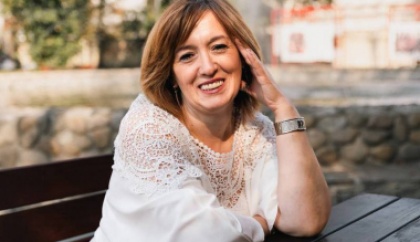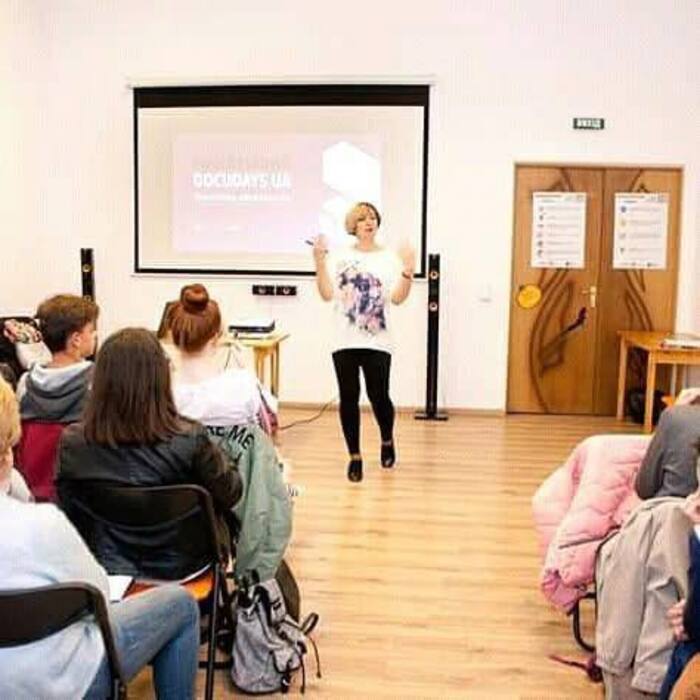
In October and November, the School DOCU/WEEK project, focusing on human rights and volunteering, was held in Ukraine. This initiative was organized by the DOCU/CLUB Network of film clubs, an effort by the NGO Docudays.
Educators from 549 educational institutions across Ukraine, who joined the School DOCU/WEEK project, screened human rights documentaries for their students, engaged them in discussions about volunteering and civic activism, organized meetings with volunteers, and provided opportunities for live conversations with the directors and protagonists of the documentaries. What were the goals of the project organizers, and were they successful in achieving them? What sparked the audience’s interest in documentary films? What opportunities do school film clubs provide for teachers and children? Nataliya Dobryanska, coordinator of School DOCU/WEEK, teacher of history and law, and consultant at the Center for Professional Development of Educators in Lviv, provides insights into these questions. “We expected the project to arouse great interest because teachers are incessantly seeking new methods of engagement. The School DOCU/WEEK offers an opportunity to employ a novel tool (documentary films) in our work with children. I see that the films and methodological materials we have prepared captivate both teachers and students,” says Nataliya Dobryanska. “Although I do not have the final statistics yet, I can already conclude that, on average, over a hundred students per school participated in the screenings and discussions. This is a significant achievement.” The aim of the project was to engage as many children as possible in various activities, demonstrating how human rights can be taught through the medium of documentary films. Additionally, the project sought to discuss the volunteer movement with schoolchildren, emphasizing its crucial role in the success of our country. Discussion of a documentary at the Docudays UA film club “We found our audience in various localities. I am particularly pleased that there were many rural schools among the participants. The pupils engaged in lively and diverse discussions about the films, interacted with the volunteers, and many of them even proposed their own volunteer activities. I consider this one of the most significant outcomes of our project,” says the coordinator. The DOCU/CLUB Network team also anticipated that many educators would want to open documentary film clubs in their educational institutions following their participation in the School DOCU/WEEK. “A sign of the project's success is that students want to continue watching documentaries. They ask when the project will continue and what other films we can discuss. This is fantastic: children are learning to think critically and engage in discussions, and teachers can form deeper connections with their pupils, discussing topics vital to their future,” asserts Nataliya Dobryanska. Dobryanska has been moderating a film club for nine years. She discovered the concept by chance during a training session for teachers. She recalls how her colleagues initially tried to dissuade her, arguing that she was too experienced and busy for such a “frivolous” endeavor. However, she decided to explore the ways to incorporate documentary films into her classes: “Why am I doing this? To avoid being overwhelmed by the monotony and indifference of everyday life. If I am indifferent, my pupils will be indifferent too. We are talking about our future here. The essence of my work is not just to impart knowledge, but to motivate children to develop by showing that learning can be engaging through non-traditional approaches.” Nataliya Dobryanska is convinced that lessons involving documentaries are much more memorable than the usual textbook work. Due to the use of a variety of creative approaches, the lesson becomes stimulating for all participants, both pupils and teachers. She explains: “Documentaries are not about entertainment at all. By the way, pupils themselves perceive it as something very important for them. With the help of documentaries, a teacher can explore a wide range of topics. These topics can be discussed using real stories of real people, with their own problems and joys. Such ‘living’ stories help students understand the subject more deeply. After all, our school textbooks are mostly descriptive – they just recount facts but do not allow us to feel other people's emotions and experiences.” 

Discussion of a documentary at the Docudays UA film club One of the most striking examples of such an impact on her students was the screening of the film Broken Branches by Ayala Sharot during her history class. “I use my academic freedom,” the teacher admits. “We watch this film in class because I know how it impacts the children: it helps them engage with the thoughts and experiences of the participants in the tragedy, which are hidden behind the dry sentences of a textbook. I would say that a documentary is a tool that allows you to humanize a textbook. During the discussion of the film, I can explain to children why certain events occurred, which human rights were violated, and how society should have reacted to these events. I am convinced there is no better tool for engaging students in these topics. In the course of such discussions, they become active participants in the learning process and learn to think independently. For me as a teacher, this is one of the most important tasks.” Nataliya Dobryanska says this form of work often yields additional, completely unexpected results. For example, in her school, during a discussion of the film Srulik by Noa Levin, one of the girls in class admitted that she was being bullied because of her skin color. The girl didn't know who to turn to or how to talk about it, and she could only open up during the discussion. This conversation prompted the teachers to pay increased attention to the problem of bullying and do the necessary work to protect the child and remedy the situation. “I have to admit that students really appreciate the opportunity to discuss things with the teacher and with each other,” says Nataliya. “I have a rule: never avoid their difficult questions, even if they are not directly related to the topic of the lesson. If children are interested in something, I make sure to take the time to answer them. These five minutes of class are invaluable, as they help my pupils see me as someone they can turn to for advice, support, and answers to important questions.” This method of teaching is proving to be effective. According to the teacher, her pupils are actively engaged in the classroom: “I follow the standard school curriculum, but I have an added bonus: my students are genuinely interested in the lesson. I am most pleased when they say, ‘I wish all lessons were like this!’ Sometimes I wonder where their energy and enthusiasm come from, but if they expect something extraordinary from me, I make sure to deliver. We live in challenging times, but the film club helps me stay motivated even under these circumstances; it energizes me.” Although this year's School DOCU/WEEK project has come to an end, educators now have the opportunity to continue using documentary films in their classrooms on a permanent basis. “I am willing to provide teachers who are interested in new effective forms of work with any help and advice,” says Nataliya Dobryanska. “It is really easy to include documentary films in the educational process. Our team has prepared a special manual for teachers.We have a grateful audience of schoolchildren, and for their sake, we must pass on the message of empathy and concern for one another. Only then can we raise our students to become real citizens and decent individuals.” Author: Olha Gurgu, journalist This publication was prepared with the financial support of the German Marshall Fund of the United States of America. Its contents are the sole responsibility of the NGO Docudays and do not necessarily reflect the views of the German Marshall Fund of the United States.



